







And I didn’t hold out for very long: my story began on the other side. My story on the tracks of the film began with an introduction in the form of a transgression. The word is perhaps a little strong but it wasn’t something trivial to cross over the Elbe by the Domitz bridge and thus to "go over to the East" into a land that is today called the former East.
Formally, we might say that as a road movie, the main setting is the road itself, marked out by the country cinemas or Bruno's truck. But in reality, THE main setting of the film is none other than this inner, dividing frontier whose history unfolds as if it were glued fast to it, stumbling against a memory buried there, against a void: a no man's land.
In my view, this is the main setting of the film and yet it is systematically off camera, or in the background, always inevitably far off, because we cannot cross this particular frontier, because it creates a genuine divide.
"The characters of Kings of the Road wander in search of themselves, over the territory of their birth, seeking to escape this feeling of strangeness that prevents them from fully existing (...) It seems that a break in the transmission of a family and collective memory is at the root of the characters’ existential malaise." (Jenny Brasebin, Reconnecting the threads of memory, 2007 Hors Champ)
This feeling of strangeness in a land without heirs is described in the following terms by Wenders, for whom Germany at that time "seems like something that no longer exists. Or that hasn’t yet begun to exist again. A vacuum, if you like." (Wim Wenders, The Act of Seeing, 1997 Faber and Faber)
DOMITZ, on the other side of the film. Following the walls and traces of memory.
Walled interiors and outside I’m struck by the silence. The immediate feeling that once torn down, the "wall" had irremediably conserved its roots, continuing to divide from within, repelling in multiple ramifications.
Germany reunified, the wound closed up and healed, but still the scar.

An Aussichtsturm, an observation tower that has been preserved on the east bank of the Elbe at Lenzen, not far from Domitz. From up there I could see the phantom fromtier. From up there I could see what used to be called "the West", on the other side of the Elbe.
At the foot of the memorial tower, I took one of the numerous ferries that today allow us to cross the Elbe. At that instant I had the feeling of at last being "landed" on the banks of the film, that from that point on I was beginning the first chapter.
Je suis un paragraphe. Cliquez ici pour ajouter votre propre texte et modifiez-moi. Je suis l'endroit parfait pour raconter une histoire, et pour vous présenter à vos utilisateurs.
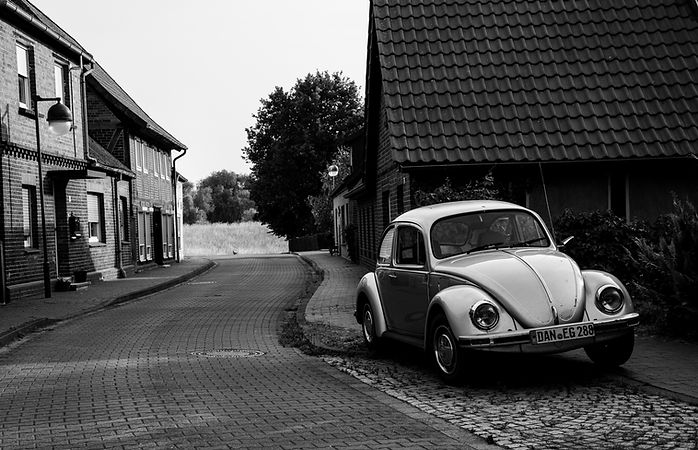
Schnackenburg, a small village on the banks of the Elbe. I’ve always wondered if Robert's Volkswagen was still there at the bottom of the river...
Before launching himself into the Elbe, Robert stops at a small petrol station at the intersection of two roads. It’s the surreal scene of the "Benzinstation" which is populated by children, with the adults apparently having deserted the place. A scene with no dialogue in which Robert and a little girl straddling her space-hopper communicate with signs.
No petrol, no adults, no memory...
 |  |  |
|---|---|---|
 |  |
 |  |  |
|---|
It’s both the very first film-set I found and... the most obvious one! But to find it, I had to freeze frame just as Robert passed a signpost. Logic is relentless: in forty years everything changes except distances, it's just maths. The signpost standing at an intersection showed Lüchow 14 km and Gorleben 4 km... I just needed to study the map.
Happy as I was to discover this first setting, I discovered that the service-station no longer existed and that there was now a house standing in its place. I headed for the garden, where a woman was apparently preparing to receive dinner-guests. It was the weekend, the end of a hot day. I went up to the gate and asked her if there had been a petrol station there in 1975. She immediately answered me with another question: "Wim Wenders? Im Lauf der Zeit?"
Though taken aback by her quick wit, I wasn’t totally surprised... she must have simply heard about this little anecdote concerning the history of her house. But I was just about to be totally surprised: "I’m the little girl", she said with a big smile.
So Ilka was none other than the little girl who figured in the scene with Hanns Zischler, and now forty years later I’d found her exactly in the same place! And in fact Ilka was just as surprised as I was... it was the first time that a guy had just turned up in her garden like a pilgrim.
As we were trying to communicate on our memories of the film, her guests started to arrive, including her daughter who, seeing me cursing the flat late-afternoon light, pulled a reflector out of her hat... As for Ilka, I had the impression that my unexpected visit and the interest shown in her short (but memorable) career as an actress filled her with joy. I was touched by her joy, and the pride that Ilka seemed to be trying to bottle up inside herself, as if she feared she might forget that she was a woman and a mother who had to run her household and welcome her guests properly.
The idea occurred to us just like that, probably because, with my non-existent German and her faltering English, we were having some trouble communicating...
Ilka invited me into the living room of her house so that we could watch the scene together. I noticed that the DVD was already loaded into the player... whereas I was far, very far, from being expected.
The Volkswagen roars up to the intersection and stops at the small Benzinstation...
A magical moment:
Robert and Ilka look at each other...
And Ilka and Ilka look at each other ...
But Ilka hasn’t finished surprising me yet: she points to a little boy standing in the background among the extras... does she know him? Of course she does - it's Andreas, her husband: true story!
After my initial surprise, I realized that it wasn’t a case of random coincidences but of simple circumstances that were linked to the way the filming-trip played out. The only stroke of luck I had was that Ilka was actually there the day I called by. And I can easily imagine that day in the summer of 1975 when Wim Wenders and his team turned up at the little petrol station to shoot a scene. Some children from the neighbourhood were recruited for the occasion to take part as extras, and Wenders chose the owners’ daughter to play the scene with Hanns Zischler...
There was nothing that extraordinary about the fact that some years later Ilka's parents closed down the petrol station and built a house and garden on their land. Ilka got married to a childhood friend who also figured in the film, and that was all...
It was simple. It was obvious. It was real, just like Ilka and Andreas’s grandchildren who had today taken possession of the garden and started playing hide and seek...
 | 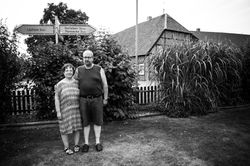 |  |  |
|---|---|---|---|
 |  |  |
 |
|---|
 |
 |
 |
I was coming from Hamburg, hitting the road from Hamburg. Leaving the suburbs and the majestic docks behind, I immediately got down to driving up along the River Elbe. Going back up the Elbe and going back in time, shaking up memories of the film and of these places, through setbacks, detours and encounters. From the very first kilometers coming up against dikes, exploring the little roads in all directions, already in search of the "settings".
"My stories start with places, cities, landscapes and roads. A map is like a screenplay to me." (Wim Wenders, The Logic of Images, 1991 Faber and Faber)
What might have become of the settings of a film forty years after it was shot? I was certainly being driven by curiosity, and it was this that gave me the directions I should follow and the points on the map... but that was not enough to explain the kind of secrecy and fascination that were beckonong me on to tread in the footsteps of the film:
"I firmly believe in the story-building power of landscapes. There are landscapes, be they cities, deserts, mountains or coasts, that literally cry out for « their stories » to be told. They evoke them, even make them happen." (Wim Wenders, Once)
Beyond the mere anecdote ("this was where Wenders shot a scene"), it was this invocation of places, space and time that appealed to me, the invisible frontier between reality and the film setting, settings seen as jewel-cases for the interwoven stories they harbour... the story told by the film, the story of its shooting, the history of the regions and the country in which it unfolds, and now, in the present, my personal little story: the story of my journey.
Opposite Domitz: probably the place where Robert hurls his Volkswagen straight into the Elbe, under the bewildered eyes of Bruno. An essential setting, the "accidental" meeting point of the two men and the driving force of the film: from that point on, they will do the road together.
"Wenders’ characters can’t stand living alone or living with others."
(Peter Buchka, Wim Wenders, 1986 Rivages/Cinéma)
 |  |  |
|---|---|---|
 |

As I strolled along the banks of the river at Hitzacker, between the cobblestones of the road and the sand that was redolent of wanderings, the late evening sunlight threw tracks and footprints into relief, images of a passing someone or something, a past to be explored. I then literally bent over this past, seeing there the tyre-marks of the Volkswagen that Robert launched into the Elbe, those of Bruno's truck that bore these two "kings of the road" along, and my own footprints following in the tracks of their story.
As the raking light printed my shadow on the landscape, I thought again of the advice given to parents trying to find a lost child on a beach... walk with the sun in your back, a lost child always walks with the sun in its back... no doubt because my relationship with photography is similar to the one a "lost child" has with the strangeness of the world.

Kirchstrasse, Church Street: the first cinema in which Bruno does maintenance work on the projectors. I easily found the street, but not the picture-house... so I followed in Robert's footsteps to Wallstrasse.
 |  |  |
|---|---|---|
 |
 |  |  |
|---|
West bank, the conquest of the west? Here, it was rather the case that the West conquered Germany after the war, "which leads Robert to say quite rightly that "the Americans have colonized our subconscious." Indeed, it seems that references to American culture have as it were replaced elements of German culture in the memory of the so-called "sons’ generation" (...) The characters who populate the world of Wenders, refusing this over-heavy legacy and replacing it with the symbols of an opulent America, thus end up losing their true identity in favour of a myth, with all the artificiality that goes with it." (Jenny Brasebin)
Even today, the small border museum in Schnackenburg (the Grenzlandmuseum) flaunts its merits via a pin-up. Not much further on, as I come upon a bumper-car arena, I’m projected back into the fairground scene at the heart of the film in which Bruno flirts with a cinema cashier. Here, the scene is set but it seems lifeless. The place is deserted.
Robert gets back on the road, I get back on the road.
He drives off at top speed at the wheel of his Volkswagen, his eyes closed.
I follow him from afar, my eyes wide open.
As it leaves the banks of the Elbe, Bruno's truck drives past the Brückenschlag, a bridge that was destroyed on April 20, 1945, five days before "Elbe Day" which marked the junction between the American and the Soviet troops.
Just like the Elbe, the natural frontier that literally barred Robert's route, it stands as another strong symbol of a barred route, of a fracture.
On the road between Lüchow and Wittingen.


It was a scene shot close to a small Texaco petrol-station and as often happens when they stop somewhere, Bruno and Robert each go off separately to do their own thing, as if they were returning irremediably to their individual solitudes.
While Bruno goes into the shack which serves as a filling-station to fill up a water-can, watched by a guy with near-demented eyes standing as immobile as a stone, Robert crosses the street to use a phone that he grabs through the window of a building which, judging by its facade, seems to be a large farm.
There was just one clue to the fact that the scene takes place near a town, but it was an important one: by freeze-framing as the camera tracks Robert’s movement, we can make out "Wittingen" on a sign in the background.



The natural confidence of Karl Reuter would have been enough to convince me, but having become genuinely interested in the matter, the car mechanic pulled out an aerial photograph of the area from his archives which dated from around the time he’d set up his garage there. There was no room left for doubt - the cooperative had indeed been located there, now easily recognizable.
Pastor Blomberg then went with me to Stocken, the hamlet 5 km north of Wittingen where the petrol-station had stood. Another friend of his guided us to the exact spot. I checked from the film stills I’d saved on my mobile: it was indeed the portion of road where Bruno and Robert stop.
Flowerpots had replaced the petrol pumps and as in the case of Ilka, a house and its garden had sprouted on the site of the former service-station.
 |  |  |  |
|---|---|---|---|
 |  |

Industrial zones, artificial lakes connected with the digging of the Seitenkanal (a canal linking the Elbe up with the Mitteland canal in Gifhorn), a meticulous inspection of the region via Google Earth to pick up the slightest clue: I focused all my efforts on locating a very special setting from the film.
It’s a scene in which Bruno pulls up at the side of a road "to have a pee", as he says to Robert. As so often, Bruno stays on one side of the road (on his side) and Robert crosses to the other side: each of them doing his own thing. While Robert discovers an immense ore-mining site down below the road (a landscape which he literally jumps and disappears into), Bruno walks off between some dunes. It was probably the place where the sand produced by the mining activities was heaped up, but the shooting angle immediately conveys the impression of suddenly being somewhere in the middle of a desert.
Bruno unbuttons his dungarees, squats and defecates. Amazing, yet the scene seems just as natural as the act it describes. Surprising but in no way shocking, or rather...
After visiting several industrial sites, I ended up finding the exact setting, practically unchanged, with the sand dunes still on one side of the road and the quartz mining site on the other…



From outside, Wolfsburg station looks as unchanging as the huge chimneys of the Volkswagen factory that tower above it. But inside, the empty stare of a winged chimpanzee has pride of place in the modern aseptisized station. Despite exploring every nook and cranny, it was impossible to find any sign of the toilets and the little cafe where Robert recites the possible destinations, leaving from Wolfsburg, like a litany...

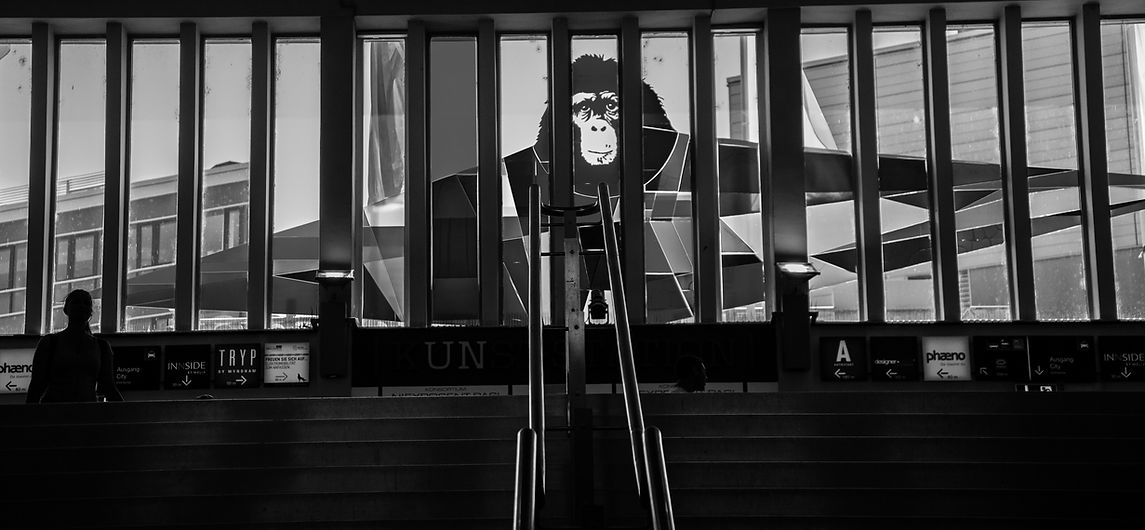





As I took the road to Helmstedt, I had no idea of what had become of the Roxy, one of those Lichtspiele whose demise Wenders had foretold.
The previous night, a violent storm had blown down some trees and certain roads were blocked. As I followed one deviation after another, I strove to stick to the frontier.
It was the first time I’d ever entered a cinema setting, a picture-house as a film-set, and I patiently waited for the cashier-girl to finish selling her tickets before explaining the reasons for my coming.
Angelika welcomed me and then told me something of the history of the cinema since the shooting, the serious illness of the owner of that time and the acquisition of the Roxy ten years ago by four cinema enthusiasts: Angelika herself, her brother Harald (who had already worked there for many years) and a couple named Martina and Mathias, who were friends of theirs.
Angelika opened the doors for me. We tiptoed our way across the darkened cinema auditorium and I discovered the narrow staircase leading up to the projection booth. I immediately recognized the place: the projection booth, "Bruno’s" projector, still there despite the digital projector, and then the small adjoining room. Angelika was embarrassed by the prevailing untidiness, but I reassured her: I was as brimming over with happiness as the room was with its clutter: the very air breathed rolls of film, reels and the wallpaper of the 70s, and even Bruno’s tools....
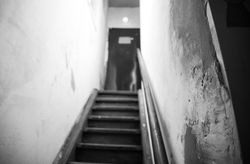 |  |  |
|---|---|---|
 |  |  |



Ben worked on an industrial site but he would come to give a helping hand at the Roxy whenever he could, purely for the pleasure of it. Harald asked him to show me something. He cleared a table of the objects cluttering it and I saw that it was the chess table that figured in the film. A games table acting as a film prop.
 |  |  |
|---|

Two of the three windows in the facade have been filled in. We see Bruno framed in one of them. Bruno, looking down at Robert. Robert coming out of the cinema by a small side door. It’s been walled up. But it’s still there, walled up in the silence of memory.
I waited for the end of the showing. I left Helmstedt with this image in my mind, the image of a living picture-house, without suspecting that it would finally be the one and only one...
 |  |  |
|---|---|---|
 |  |

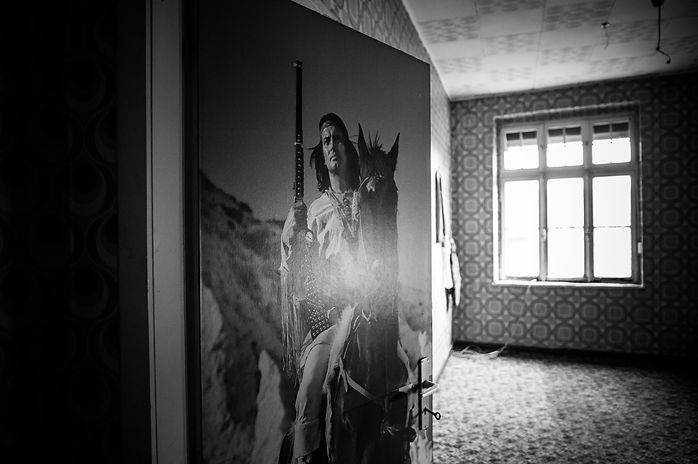
On the ground floor, Markus began by opening the door of a small storage room in the restaurant lobby. It was the precise spot of the former cinema’s box-office and there behind the shelves filled with candlesticks and plastic flowers appeared the first traces of the phantom picture-house: tattered remnants of movie posters revealing a strange sort of cohabitation in this their final refuge.
Markus explained how the building had been converted. The cinema auditorium had been cut in two horizontally with, on the ground floor, in addition to the the dining-room, the creation of a space given over to playing "Ninepin Bowling Classic", a variant of the skittles game that was very popular in Germany.
I walked slowly along the corridor leading to a last room which appeared like a sanctuary, guarded by a proud, valiant Indian warrior astride his mount, when, as I crossed the threshold...
I called Markus, I had to share my amazement with him: "Markus, come and see this, it's amazing, look, just look at that sticker on the wall!"
As he didn’t understand what might have caused such amazement on my part, I explained to him that "Kings of the Road" was the English title for "Im Lauf der Zeit": I thus found myself in the setting of a film, the remnants of a film-set picture-house and I’d stumbled on the title of the film, the name of a truck glued to wallpaper which had remained unchanged since the 70s...
In truck’s name! ... I was amazed! ... And I turned round to look at the Indian again, realizing that he was indeed the guardian of a sacred shrine.
While Wenders chose this English title in reference to the Roger Miller song that’s on the film’s soundtrack (King of the Road, 1964), I allowed myself to entertain the idea that while he was shooting here, he may have entered this room too and then noticed the sticker with the effigy of a truck named "King of the road", or perhaps he even stuck it to the wall himself! That was the state I was put into by simple coincidences that then appeared to me as being the signs of something... but the signs of what, except that I was aiming right?
And my aim was to find the film-sets, so I pulled myself together and questioned Markus about the way the auditorium had been divided up: did the upper level really correspond to the auditorium itself, above the restaurant and the bowling-alley? Having become genuinely interested himself, Markus took me ourside to the other end of the building, to try to open a door which he thought might lead to a space which hadn’t been touched at all, above the concrete flooring that split the auditorium in two.
As soon as I got to Schöningen, I’d had an intuition that it was here that a pivotal scene of the film had been shot: the cinema is full of children accompanied by a teacher during an outing from school. Which film they were supposed to be seeing we’ll never know because Bruno is working to repair the loud-speakers in the space located just behind the screen. As the young audience starts to get impatient, Robert switches a lamp on and their silhouettes are suddenly projected as shadows on the screen.
Robert and Bruno then start to improvise a soundless, chaplinesque sketch for the sake of the heartily laughing children. Only their teacher looks annoyed. The scene is magnificent, both because it pays homage to the early days of the cinema, with childhood moments spent "at the pictures", and plays of light and shadows, Lichtspiele... but also because it sets up a true complicity between Robert and Bruno through play, mime and humour. A sacred moment of screen-play despite a moribund cinema and a projection without a film - a unique moment of wholly childlike joy.
After trying all the keys on his key-ring in vain, Markus ended up by calling his mother. Then the door opened...



Markus too discovered the place for the first time and seemed as astounded as I was. We had found what was left of the auditorium, a half of it...
The upper half, with blocked-up windows below smaller arched windows, half of the seating-dais and finally the upper half of the alcove which had once contained the all-important screen.
And this alcove is indeed behind the screen: where Robert and Bruno had acted out their little improvised sketch.
 |  |
|---|---|
 |  |
 |  |
 |




I left Markus to finish preparing for his trip. He had allowed me to pass through the walls and behind the screen, and to be moved by a ladder, a cupboard and a sticker.
But before we parted, he wanted to show me a road. A road that I couldn’t have taken but which, in 1975, still connected Helmstedt to Schöningen. Wenders and his team would no doubt have taken it at the time, before it was permanently cut off: three villages have since disappeared to make room for a gigantic coal mine.

 |  |
|---|---|
 |
I stopped for a moment at a level-crossing, and the night scene in which Robert places a coin on a rail came back to my mind. After a train roars past, he picks up the coin again and it burns his hand. I in turn placed a coin on a rail and waited. 50 cents, half a euro, in a spot where Europe used to be cut in two. A long time went by, and then at last a train... but on the other track.
I drove off leaving my coin where it was.
 |  |  |  |
|---|
"Why are there so many trains in your films?
Ozu has trains in almost all his films too. Once he was asked why and he said it was because he was so fond of them. The locomotive with all its wheels simply belongs to the cinema. It’s a piece of machinery like the cine-camera. They are both products of the nineteenth century, the mechanical age. Trains are ‘steam-cameras on rails’. "
Interesting as this response is when you know Wender’s attachment to Ozu's work, it was that of a cinephile. Whereas a few pages further on in his The Logic of images, he looks back to the shooting of his very first film (Silver City) and a foundational experience for his identity as a filmmaker in which the train already played a leading role...
"My stories all begin from pictures. When I started make my first film, I wanted to make ‘landscape portraits’. (...) The shots were like the paintings and watercolours I’d done previously, only in a different medium. However, there was one shot that was different: it was of an empty landscape with railway tracks; the camera was placed very close to these. I knew the train schedule. I began filming two minutes before one was due, and everything seemed to be exactly as it had been in all the other shots: a deserted scene. Except that two minutes later someone ran into shot from the right, jumped over the tracks just a couple of yards in front of the camera, and ran out of the left edge of the frame. The moment he disappeared, even more surprinsingly, the train thundered into the picture, also from the right. (...) This tiny ‘action’ – man crosses tracks ahead of train – signals the beginning of a ‘story’. What is wrong with the man? Is he being followed? Does he want to kill himself? Why is he in such a hurry (...) I think it was from that moment that I became a storyteller."




After spending the night in Bad Hersfeld, I set my sights on Ostheim, the town where the scenes featuring the printing press of Robert's father had apparently been shot. I spotted the town on the map, about fifty kilometres away, and for the first time I was forced to take the motorway. I was going to stray a long way from the frontier, but after all it was also a point in the film where Robert himself leaves Bruno to visit his father.
Once there, I saw that Ostheim was a small village not far from the motorway, but that it was nothing like... Ostheim? I cursed myself for being so stupid: Robert’s Ostheim (Ostheim vor der Rhön) cropped up much further on in the film and therefore obviously much further south and still close to the frontier!
Instead of going back onto the motorway, I decided to change routes and take this opportunity to explore a road I’d never have taken otherwise. Was it an intuition I had that this mistaken identity might turn out to be a blessing in disguise? In any case, that's what I was trying to make myself believe when suddenly I had a sort of flash, but it was absolutely real: I had just driven past a setting from the film, and then two...

The two settings followed one another in quick succession... on a stroke of fate: a fixed shot of Bruno's truck going past, with the small village of Neukirchen in the distance and, as always, trains running parallel to the road... and then in Hauneck, about two kilometers before Neukirchen, which I still like to believe is the precise location of the scene with the wurst stall where Robert and Bruno make a stop-off.
While Bruno buys a Coca-Cola and a hot dog at the counter of an old van that had been converted into a snack-bar, Robert crosses the road and as he always does whenever the opportunity arises, uses a phone. In this scene it happens to be a telephone-box. It’s no longer there but it stood right in front of the facade of an imposing half-timbered farmhouse that I recognized instantly.
But what really amazed me was the presence of a snack-bar right opposite... even if it wasn’t identical to the one in the film and the surroundings themselves didn’t really look that similar. Like with the scene of Wittingen's Texaco station (where Robert crosses the road to use a telephone), might Wenders have filmed the main shot and the reverse-angle shot in two separate locations? But then, by what chance might one find a wurst stall at the exact same spot that it’s supposed to be in, in the editing? I thus have no choice but to consider that the scene was entirely shot at this place... and that suits me very well!
Speaking of the stroke of luck I had in "stumbling on" this setting after having the excellent idea of taking the wrong road, I was all the more touched a posteriori by Wenders’ anecdote related in The Logic of Images: "We would sometimes pull up on the road to shoot scenes because something in the landscape or the building happened to grab us. Once, we passed an old caravan that was being used as a mobile caff, or rather I noticed it and about a mile later I said: ‘Robby, did you see what I saw?’ and he said: ‘Yes, and I was amazed you didn’t want to stop for it.’ So we turned round, followed by the cavalcade of the crew, and we spent the rest of the day filming in and around that caff.”
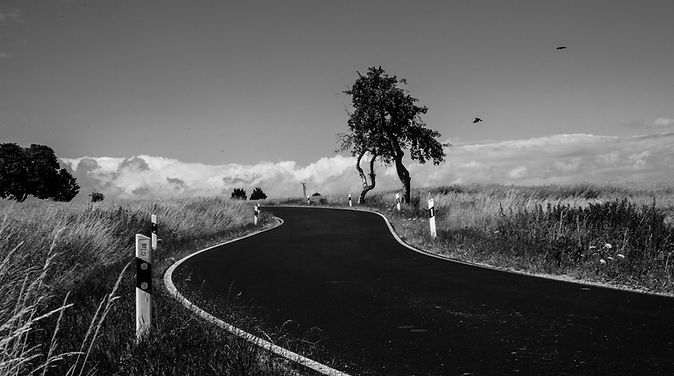
After Lower Saxony and Hesse, I reached Bavaria by following the magnificant roads of the Rhön region. I focused all my efforts on finding the setting of the Basaltwerk, a disused factory on a derelict basalt mining site in which several major scenes of the film are set, just before Robert leaves Bruno to confront his father: a dead tree, a mourning man, "Life is all there is…”
Landkreis of Gifhorn
Region of Wolfsburg
Landkreis of Helmstedt
Lander of Hesse
Landkreis of Werra-Messner


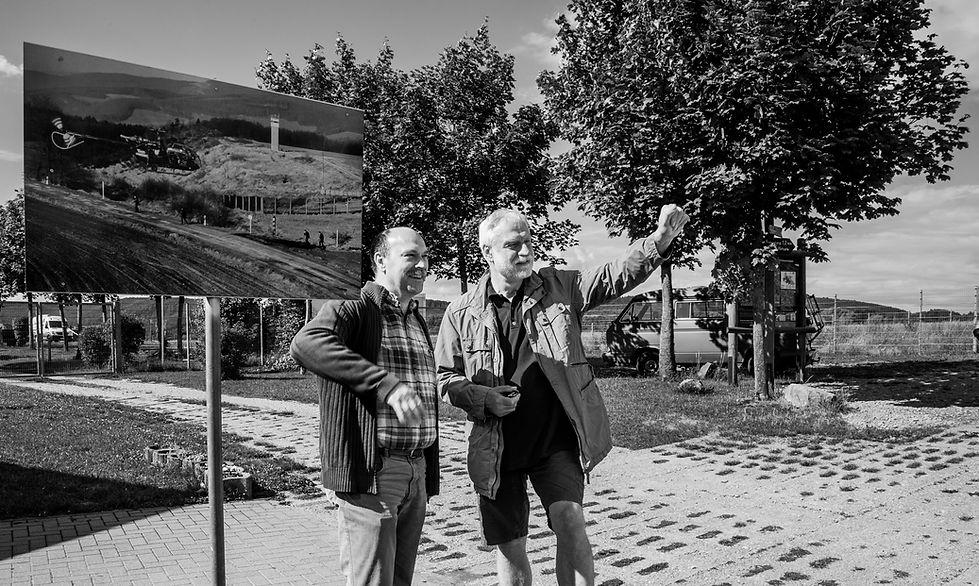

Landkreis of Hersfeld-Rotenburg
Lander of Bavaria
Landkreis of Rhön-Grabfeld and Hassberge

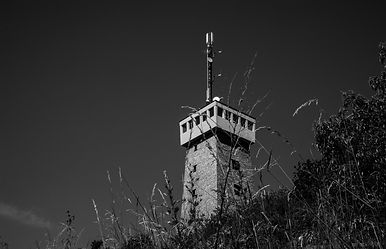

Landkreis of Kronach and Hof
Without much difficulty I found the observation tower (Aussichtsturm) which, thanks to the editing, stands in the immediate vicinity of the Basaltwerk. But it’s actually in the heart of a natural park and I could find no trace of an industrial site anywhere nearby.
I did so many miles trying to cover all the roads in the area that I came to feel a funny sort of "road sickness". I needed to move on and I said to myself that very likely the site, which already looked like a wasteland at the time of shooting, had now completely disappeared.
 |  |  |  |
|---|---|---|---|
 |  |
It was at Hassfurt, on the banks of the Main, that I got back onto Robert’s tracks. On his way to Ostheim, we see him go past the Gothic church and a large building with its easily recognizable stepped gables. A bit further on, he crosses the railway tracks at a level-crossing. While the church square hadn’t changed, the level-crossing was no longer there, but a restaurant owner pushed his backyard gate open to show me where it used to be.
It had now been several days since I’d found any setting as such, even if I had the impression I was back on the roads taken by the film. According to my list, the next settings should be in the Rhön region. But when it came to industrial wastelands or roadside settings, I needed to meet people who might be able to help me.
I pulled up at the Bad-Sooden Allendorf border museum, just before it closed. Gustav Nolte and his colleagues were in the middle of a meeting but they took time out to study the film stills I showed them.
They ended up by cutting their meeting short and devoting the time they had left before closing-time to help me figure out possible leads.
On the other side of the mountains, I stopped at Braunlage. One scene had apparently been shot there, but the picture-house had been supplanted by a supermarket. I did some shopping there but took no photos. Then Herzberg, a banal pedestrian precinct in a banal, almost deserted city centre. So the Capitol had become the Central-Lichtspiele? I didn’t push my investigations much further; on the other side of the street even the toy store was empty.
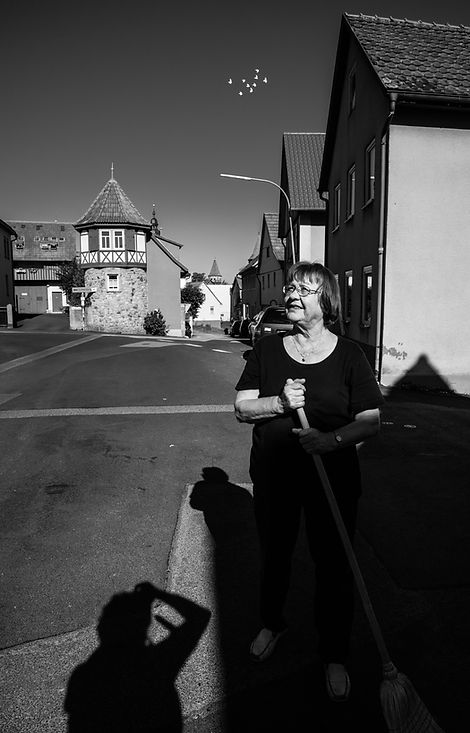
Luck, pure chance, or signs... yet another sign?
I should no doubt speak of simple "lucky breaks", but all the same...
At the end of the day I entered Ostheim for the first time. I drove along the main street through the town. At the other end of it, I followed directions for the lodging-houses advertized on a number of signs, with the idea of finding a place for the night. I took a street at random, on the right, up to the upper part of the town. As I drove towards a farm, I caught sight of some white doves wheeling round in circles in the evening light. They landed on the roof of the farm for a moment before resuming their wheeling flight.
I had just arrived in this town that I didn’t know and I had stopped my car for the very first time, in this precise place, just to take a picture of a flight of doves. A woman was sweeping in front of her house and I asked her if she minded my parking there for a moment, just for the time it would take me to take a few photos.
She was thus the first person I’d talked to, so I took the opportunity of asking her if there was a printing works in the town...
"Of course there is! And I’m the printer’s sister..."
A simple "lucky break"?... but thinking back, wasn’t it also because I was asked whether I was taking shots of birds that I’d been lucky enough to meet some friends of Hanns Zischler, right out in the middle of the countryside, at the very beginning of my trip?
 |
|---|
 |
 |
Heidrun was as surprised as I was and showed me the local newspaper, that was still being edited by the small family printing firm, then she immediately called her brother Völker to inform him of my visit.
They both remembered that summer of 1975 when, on getting back home from their holidays, they were surprised to find that their father had welcomed in a film crew.
According to Völker's recollections, Wim Wenders and his team had stayed a week in Ostheim. That didn’t surprise me that much given the impressive dramatic intensity of the scenes that were shot there and the fact that Wenders was writing the scenario on a day-to-day basis.


 |
|---|
 |
Völker was absolutely charming and his welcome extremely warm. I was immediately overwhelmed by the setting: the place had hardly changed and I had the impression I could feel the film.
He told me the history of the printing works, which had been founded by his grandfather in 1907. Handed down from father to son, it was also and above all the head office of the local newspaper, the Ostheimer Zeitung. Like Völker and his father and grandfather before him, Robert's father also devoted his life to his newspaper.
 |  |  |  |
|---|---|---|---|
 |
Völker showed me the issue celebrating the centenary of the newspaper in 2007, with the photo of his grandfather on the front page.
Then he leafed through it in front of me and paused at a page which filled me with emotion: since this issue was devoted to the history of the newspaper, there was also an article on the visit made by the filmmaker Wim Wenders on the occasion of the shooting of his film Im Lauf der Zeit…





Several components of the film-set were still there: the desk of Robert's father on which, in the film, there stands a typewriter that he seems to treasure above anything else in the world; the old Heidelberg printing press and the case containing the lead printing characters; the portrait of Gutenberg...
During the night, while his father dozes off over his typewriter, Robert finds a way to express his resentment in writing. He thus spends the night composing and then printing a page of the newspaper for his personal attention.


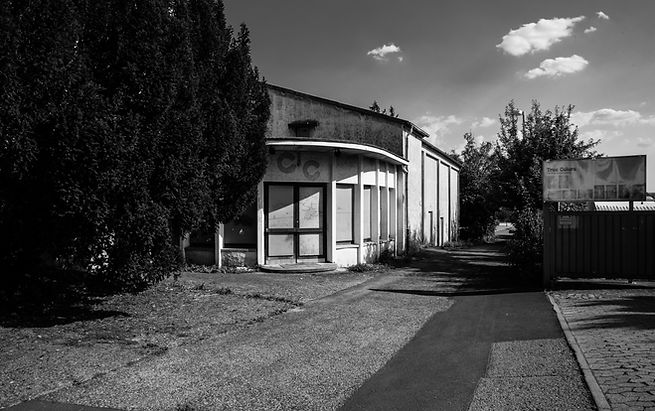
I left Völker after a final shot dedicated to Wenders’ passion for Polaroid cameras, with this one having more than done its time in the editorial office of the Ostheimer Zeitung...
Back to Hassfurt, where the C&C Lichtspiele hadn’t survived.
"No crew"
No team, no crew, no one left on board?
 |  |  |
|---|
I tried to find some trace of the owner of the place all the same. Lucia and Petra live in the same street and they gave me a few leads. But was impossible for me to contact him that day.
 |  |  |
|---|
MIT WITZ
Mitwitz, I’ve not finished writing you.
I learned only later that the name of this town meant "with wit", in the sense of a "witty saying", in short, a joke...
Mitwitz, good joke.
I’d just photographed the Lichtspiele picture-house with its missing final "e" when suddenly...
"Unformatted card, do you want to format it?" the Nikon asked me.
Can a camera be so cynical? It was asking me a question, there was even a question mark. But who really asks questions like that? Cold sweat, freeze frame, loss of memory, quickly followed by a state close to speechlessness.
Mitwitz, very bad joke.
This memory card I’d bought a week before in Helmstedt a third of the way into my trip, my mental trip, my daily joy at discovering the settings of the film, meeting the memory of the places and people that bore traces of it... it contained around 1,000 km, around 500 photos ... what carelessness! I hadn’t thought for one second that working with a digital medium required backing up your work every day.
A loss of memory: the loss of Schöningen, Markus and the Kurhaus?... of the Quartzwerk and the road to Goslar?... The road everywhere... that of the wurst stall, Neukirchen and Rother Kuppe, the Aussichtsturm?... of Ostheim vor der Rhön, the doves at Heidrun, Völker’s printing-works?... the C & C and Hassfurt church and more road, the road everywhere...
Over the following two days, the remaining two days, I tried to cling to the hope of recovering pictures that I no longer even dared to call pictures: they’d been reduced to the state of mere files, data and bytes. One bug and I was suddenly brought back to dirty, raw, brutal life, with all its attendant accidents. From then on - and this was not just an impression - the sky clouded over, the light went, the towns turned grey and congested, and nothing flowed easily any more.
Bad news from the photographer’s in Kronach and his confident team of computer specialists: impossible to format the card with any hope of using data recovery software. The controller was dead, it was impossible to communicate with the card. No memory left.
Before setting off, I'd re-read The Logic of Images, and its chapter on the film, in which Wenders writes about the nightmarish start of the film-shoot: "There was no screenplay, which was just what I wanted. But when we were about to start shooting I suffered nights of anxiety – should I structure the thing a bit more? And then a couple of times, in a panic, I started writing some feeble conclusion. Even after we started shooting I was still afraid that everything would go wrong. Then, in Wolfsburg, we got the bad news that the whole of the first week’s filming was unusable on account of a fault in the stock, and we’d have to reshoot it all. At first that floored me, but when I’d taken it in, it was suddenly liberating: what else can possibly go wrong now? Now we can go flat out! (…) Now we were ready for anything.”
Did I also manage to take it in? Yes I did.
Did I start everything over again? No…
Once back in Paris, I took my memory to a surgeon for chips, cards and all other sorts of hard drives. The operation was successful, with full data recovery. His address was: rue Louis Braille - you can’t invent that sort of thing…
I can’t bring myself to classify this experience as just another travel anecdote, it’s such an integral part of my story. I’d go so far as to say that, like Wenders who, after suffering the loss of his images, experienced a form of liberation, it enabled me to overcome my doubts about the real meaning of my project.
Since then, I invariably back up, and up, and up…
Mit Witz: with wit.


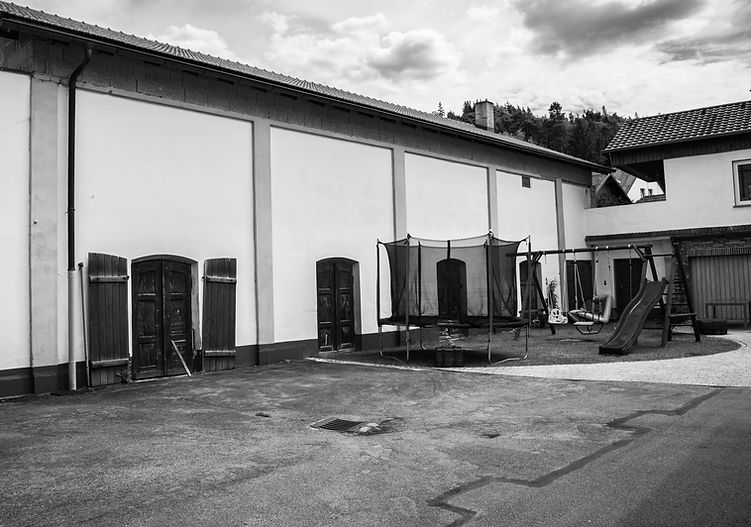
Over the days that followed, I somehow managed to drag myself along. But the trip was already over. I had no strength left to seek out any other settings or to revisit any of the earlier ones.
I still went all the way to Hof, if only to switch off the lights. It said in the synopsis that the story takes place between Lüneburg and Hof. So it was supposed to be the end of my trip, but it's actually just the last shot of the film.

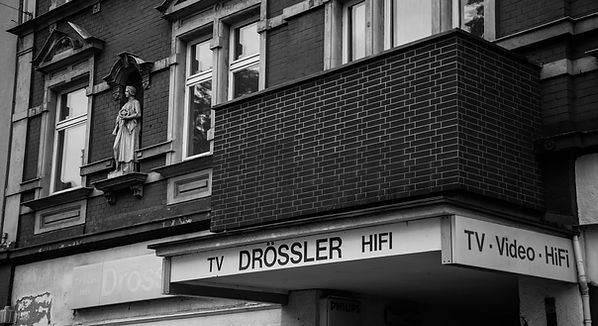

Bruno has parked there, under the neon lights of the Weisse Wand picture-house which Wenders uses to sign his film: WW, the end.
The Weisse Wand sign appears to have been walled up.
It was the last Lichtspiele Bruno visits, a cinema no longer showing films but that its owner still maintains, like a sanctuary:
"'Film is the art of seeing' my father said, that’s why I can’t watch films that are mere exploitation of all that can be exploited in human heads and eyes. I won’t be forced to show films where people stagger out stunned and rigid with stupidity, that kill any joy of life inside them and destroy any feelings for themselves and the world. My father wanted the town to always have a cinema. Me too. But it is better to have no cinema than a cinema the way it is."
History’s little joke, voluntary or not, is that the place now sells televisions…
The small, scrawny railway station of Wiesenfeld: Robert's last scene. Robert and the child. His pair of plastic sunglasses and his empty suitcase. The child's smile and Robert's smile, just before he takes a train. An undefined train, the end.

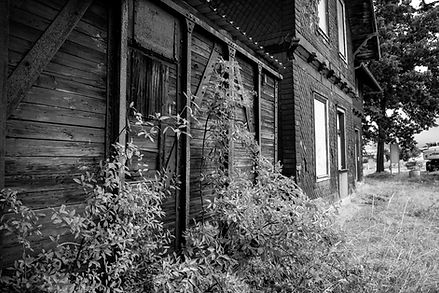

The boy sitting back against the wooden hut. He has a school notebook and when Robert asks him what he’s doing, the boy tells him that he’s writing down what he can see:
"I’m describing a station. Everything I can see. The tracks, the gravel, the timetable, the sky, the clouds."
Reverse angle: Robert standing next to the boy, leaning back against the wooden hut. He has an empty suitcase and plastic sunglasses.
A swap. They make a swap: the sun-glasses and the suitcase for the notebook.
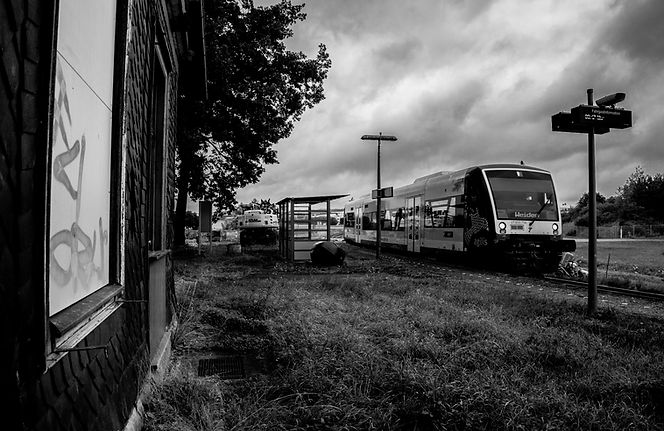
 |  |  |  |
|---|
This last setting I visited is probably the only one that struck me as being a film-set and nothing more: a real fake film-set left there, abandoned, forgotten somewhere at the end of a dead end, itself just one more setting among others in a large, empty film studio. There, between past and present. Between film and reality.
Today the station boils down to a small metal shelter, a lamp-post and an illuminated sign showing the train times. It's functional. But in the background there’s a story and I’m writing what I can see: a train stops, no one gets down, nobody gets on, and the train leaves again.

Actually, that’s not quite correct. Something invisible did get on that train. That thing is my journey that’s just ending and my story that’s just beginning.
The present is already a thing of the past, I’ve recovered my wits and I must say that since Mitwitz... I’ve been preparing myself.

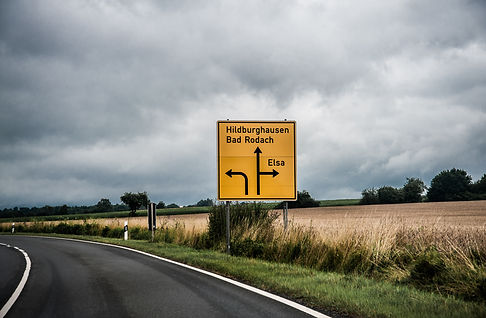
I’d spotted her name on the map, not far from Wiesenfeld.
My first great love, both excessive and agonizing.
It goes back a long way, but it was the first one.
So of course, one final detour was de rigueur.
Before going back to Paris, not Texas….
Elsa, Bavaria.
But while the ground floor of the former cinema auditorium had been completely done up, the same could not be said of the upper level. When Markus took me up there, we had to move very cautiously because in places the flooring was unsteady. This upper level already existed at the time and was probably located in the back of the projection booth, empty rooms that I walked through with the feeling I’d gone back in time...
 |  |
|---|
The mountains were behind me at last and little by little I found the road again: fields and valleys full of nuances, false hues below a menacing sky, but I liked it. I found the road again thanks to the trains, and the rails: at that point in the film, Bruno’s truck drives more and more often alongside railway lines. I was really and truly back in the film…
I arrived in Mitwitz, to find the ghost of yet another cinema. The Frankenwald Lichtspiele was fading away with time. I still don’t know which scene was shot there, because any shots of the outside were edited out and the place was doomed (my choice of words).
I gleaned some information there too, to try to find some trace of the owner, and I started to photograph the walls that still bore witness to the memory of the place.
 |  |  |
|---|
Lichtspiele: I was starting to like this word, to enjoy pronouncing it.
Kleine Lichtspiele... little plays of light... and I thought back to the laughter of the Schöningen children watching the plays of light dreamt up by Robert on his piano and Bruno on his ladder.
In the adjacent courtyard, the side doors of the small cinema were locked, there was no light play now, just a small playground with no children.
And then it was the end, the end before the end.
The frontier, an interior no man's land, a scar of History


"Kings of the Road is also a film about the end of the cinema." (Wim Wenders, The Logic of Images)
As I came upon this little closed cinema in Domitz - a Lichtspiele whose "plays of light" had been put out some years before already - I immediately realized that through my journey I would be able to gauge the reality of what Wenders announced forty years ago, in the very first sequence of the film: "Just imagine, in a few years there'll be no cinemas left in small towns."
 |  |
|---|---|
 |  |
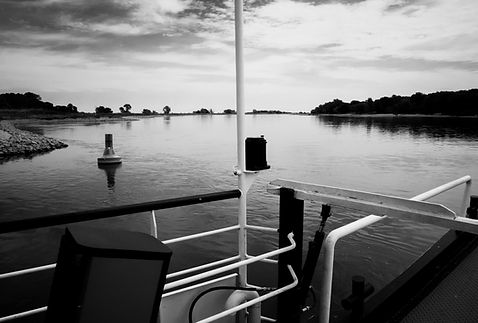

"Wall Street” : Robert stops for a moment on the small bridge under which a group of children are having fun making paper boats. He joins them and sits down at the bottom of the steps. Robert borrows a newspaper from them before the day’s news also flows away, with time, like the water.
More than once during the film, Robert buys a newspaper or finds one on the ground, as if to reassure himself on the way things are going, the way the world is going. They were often local newspapers, and were hence clues that enabled more precise identification of the regions they drove through.
It was the editing that had allowed Wenders to link up the two places, via a simple, fairly standard geographical ellipse. While at first this possibility seemed to go against the realistic nature of the film and the contingencies of the shooting, it immediately forced me to a renewed awareness that it was cinema after all, and that Wenders had totally mastered the way his film was put together:
"I wanted a completely cinematic feel. (…) We wanted our adventure to show in the film, but not in its style or its appearance. (…) The last thing I wanted was for it to look like a documentary film.” (Wim Wenders, The Logic of Images)
And that is how we can fully measure the challenge set by a film whose critics say that it "documents reality". But how do you manage to give a real account of reality while using all the tools that the cinema affords: artificial lighting, tracking shots, cranes, etc.... It’s a marvellous illustration of what film-making can be: making things real is one thing and it is in fact the essential property of fiction, but over and above the artifices, rendering reality is a much more demanding exercise.
"For the first time I see myself as someone who’s gone through a certain time, and this time is my history." (Bruno)
... surprising precisely because it is not shocking.
In a 1976 interview, Rüdiger Vogler was questioned on this scene: "I was supposed to have a pee, but I couldn’t keep on peeing at each shot, so at one point I said: "Next time, I'm going to have a shit"... but it's not that important."
In any other film (where the story is fragmented as part of a scenario built and thought through upstream of the shoot), the scene would no doubt have seemed shocking : written in advance, and hence programmed into a work schedule, it would inevitably have assumed a transgressive fuction, causing either laughter or disgust... But not here, not with Wenders, for whom the scenes portraying the everday life of his characters carry within them a narrative function which is none other than that of bearing witness to their existence... and which can only be conjugated in the present.
In the same interview, something said by Rüdiger Vogler perfectly sums up this interpretation: "A film is always something like an image of reality (...) An actor is also the image of a real man."
And this is indeed what takes precedence throughout the film over the idea that a scene is supposed to "keep the story moving" by narrating something at all cost. And it's also what makes this film a unique object in the sense that, as far as I'm concerned, Wenders has never elsewhere gone so far in his desire to bear witness to a story rather than thinking it up.
In the introduction to his The Logic of Images, Wenders answers the question "Why do you make films?" :
"I was twelve years old when I made my very first film, with an 8 mm camera. I stood by a window and filmed the street below, the cars and pedestrians. My father saw me and asked: ‘What are you doing with your camera?’ And I said: ‘Can’t you see? I’m filming the street.’ ‘What for?’ he asked. I had no answer. Ten or twelve years later, I was making my first short film in 16 mm. A reel of film lasted three minutes. I filmed a crossroads from the sixth floor, without moving the camera until the reel was finished. It didn’t occur to me to pull away or stop shooting any earlier. With hindsight, I suppose it would have seemed like sacrilege to me.” (...) « I can’t give you Béla Balazs’s exact words, but they affected me profoundly all the same. He talks about the ability (and the responsability) of cinema ‘to show things as they are’. And he says cinema can ‘rescue the existence of things’. That’s precisely it. (...) So back to the awful question : why do I make films, Well, because… Something happens, you see it happening, you film it as it happens, the camera sees it and records it, and you can look at it again, afterwards. The thing itself may no longer be there, but you can still see it, the fact of its existence hasn’t been lost. (...) The camera is a weapon against the tragedy of things, against their disappearing. Why make films? Bloody stupid question!”
Wolfsburg
After arriving in Helmstedt and gleaning a few bits of information, I was finally told how to get to the Roxy.
I crossed the street at the same time as some children, accompanied by their father. They were holding each others’ hands and I realized as I followed them that a showing was about to begin.
An animated film... animation: Helmstedt's Roxy was alive and well!
No doubt blinded by my enthusiasm, it didn’t occur to me to open the drawer, as Robert did in the film, to find inside a porn magazine and a syringe... 1975: Wenders portrays the slow agony of small-town picture-houses, revealing a decline in programming linked to both the pervading cultural void and purely economic contingencies:
"I learned a lot about the condition of rural cinemas, especially from the recces. It was noticeable that most of these cinemas belonged to women, who went on running them with a real passion, and against any economic sense. (…) The distributors – those who still bothered to supply these village cinemas – treated these women like dirt. For instance, none of these cinemas was allowed to determine its own programme, or ask for anything: if they wanted to be supplied, they had to take the whole package, all that demeaning crap that only runs in sleazy downtown areas in cities.” (Wim Wenders, The Logic of Images)
It was hence images of violence and sex that covered the screen. Bruno maintains the projectors as we follow him from one picture-house to the next, and yet "cinema" seems to be a thing of the past. There’s no talk of cinema but only of how it used to be. Bruno only seems to be maintaining the projectors so that films worthy of the name might one day at last be screened again....
Meanwhile the reels turn for nothing and the projectionists jerk themselves off…
Schöningen
 |  |  |
|---|
Markus had never seen the film, so he couldn’t know that in that scene Bruno was standing on a double ladder, just behind the screen...
But the first thing he did on entering the room was to climb onto a ladder that was leaning there, just behind the now invisible screen.
The ladder gave access to the attic, but it was much too unsteady and neither of us climbed any higher than the third rung...
The only remnants of the picture-house that we found there ware: a small part of what must have been a doorway into the auditorium, behind the screen; and the remains of the lamps that used to decorate the walls on either side of the screen.
Having stopped at another level-crossing, I grabbed hold of my camera. Attentive as I was to my settings and the speed of the train when I shot the photos, it was only later in the evening when I was sorting through my pictures that I notice the tag on the wall: "No Nazis"...
Thus the same phenomenon had occurred: while taking a picture without any particular intention, a "story" gate-crashed it and literally transformed it. Except that here, it was History that was the intruder and which suddenly, by its very nature, opposed the very possibility of telling stories.
Throughout my trip, I was constantly surprised and delighted by the receptiveness of all the people I regularly sought help from. For the most part, they seemed to get genuinely interested and did everything they could to shed any light they could. Yet very few of them had actually seen Im lauf der Zeit and surprising though it may seem, more than once I even had to tell them that Wim Wenders was a great German filmmaker! ... Be that as it may, when I showed the pictures from the film and summarized the story, I could clearly see how their interest was aroused. Indeed, I had the feeling that it was THEIR (hi)story.
An obvious truth thus struck me very quickly: of course I was discovering a territory, landscapes, and my beloved settings on a solo trip... but I would never have had any access to the memory of these places without the meetings I made, and I realized that beyond the "obsessive" side of my quest, they mattered as much to me, if not more, as finding the film settings themselves.
 |  |  |  |
|---|---|---|---|
 |
The belvedere had been turned into a somewhat unusual hotel which was closed on the day I got there. So I decided to put off my visit so to be able to climb to the top, like Bruno does in the film.
Here again, the two film settings have been brought together by the magic of editing and I spent hours and hours searching for the Basaltwerk. I was nearly certain it was in that same area, whose industrial past is indeed bound up with basalt mining.
Ostheim vor der Rhön
Hof
A railway station platform, the final film-set.
"Children have a sort of admonitory function in my films: to remind you with what curiosity and lack of prejudice it is possible to look at tha world." (Wim Wenders, The Act of Seeing)
Lüchow
A long day combing the town to find a setting from the film. By dint of perseverance and acting on advice from the local newspaper, I finally met the person who could help further my investigation, Pastor Blomberg. Everyone knows him in Wittingen and the history of the town has no secrets for him.
The current owner told us that the man with the maniacal eyes who had figured in the scene with Rüdiger Vogler used to live there and that he was a blacksmith: Hermann Schultz was no longer of this world but judging by the ensuing animated conversation between the current owner of the place and the pastor's friend, he had left behind him a good many memories... clearly a strong personality! This didn’t surprise me too much given that his presence on the screen does indeed produce such a strange effect.
Hassfurt
One last detour
On July 1, 1975, Wim Wenders and his crew began filming Im Lauf der Zeit (Kings of the Road), with Rüdiger Vogler (as Bruno) and Hanns Zischler (as Robert) in the two lead roles. They set off along the frontier between the two Germanies with one page of scenario (the beginning of the film - the meeting between the two characters), following a route punctuated by Lichtspiele – these small country cinemas which were shortly doomed to disappear.
On July 1, 2015, I set off on my own, on the trail of the film. The project had suddenly occurred to me a few days before. It was my first trip to Germany and in the most complete improvisation, I in turn hit the road with a map, a few stills from the film and my camera. I first stopped off in Düsseldorf, at the Wim Wenders Foundation, where I obtained a list of some of the filming locations - the film settings that I would now try my very best to locate.
At the outset, my initiative was a matter of simple photographic research. Having decided to set off on an impulse, I had no idea of what I might find along the way, nor that these images might give rise to a story. As for the reasons that literally pushed me to undertake this "trip", they were both multiple and personal. But the main motive for this personal quest was the impression left on me by the discovery of Kings of the Road at the Saint-André-des-Arts cinema twenty-five years previously, when, as a young man with an insatiable appetite, I took full advantage of a retrospective on Wim Wenders which was being presented in this art-house cinema in the Latin Quarter of Paris. It was thus that indelible memory of my experience as a spectator that suddenly manifested itself, a memory transformed into a single-minded desire which immediately took the form of movement, as a real priority : to hit the road.
A few days before leaving, I watched the film again and right from the first frame, there I was, immediately "in its grasp" again: a board describes the circumstances of this filming trip “shot in eleven weeks, between July 1st and October 31st 1975, between Lüneburg and Hof, along the frontier with East Germany"... now it was the end of June and very probably I would thus necessarily be following the trail of the film forty years to the day after it was shot. Pure chance, for sure, but at the end of such an experience I must admit that the notion of "chance" gradually faded out of my mind, to be replaced by that of "signs"...
Je suis un paragraphe. Cliquez ici pour ajouter votre propre texte et me modifier. C'est facile.
 |  |  |
|---|
Landkreis of Lüchow-Dannenberg
From Schnackenburg onwards, the frontier leaves the bed of the River Elbe and runs due south, from here on, it’s even more unobtrusive.
Early that Sunday morning, on a narrow country road along the phantom border, I catch sight of a man and a woman. They're wearing nothing except a towel around their waists.
As I come up to them, I ask them if the road is suitable for cars. They say it is, so I make to overtake them...
 |  |  |  |
|---|




Düsseldorf, an improvised visit to the premises of the Wim Wenders Foundation in search of a list of film settings before going to Hamburg and taking the road featured in the film. Düsseldorf, the filmmaker's hometown, my first steps in Germany... barely out of the train-station and a first image fixed itself in my mind by way of prelude to my trip : the statue of a photographer, mounted on an advertising column and, just behind it, in full line of sight, the signboard of an old cinema. An image symbolising both the end of the cinema (one of the major themes of the film) and the genesis of Wenders’ own cinema (filmmaker as a photographer).
"A photograph is always a double image, showing, at first glance, its subject, but at a second glance – more or less visible, "hidden behind it", so to speak, the "reverse angle": the picture of the photographer in action. (...) Yes, forwards, a camera sees its subject, backwards it sees the wish to capture this particular subject in the first place, thereby showing simultaneously THE THINGS and THE DESIRE for them. (...) Through the "viewfinder" the viewer can step out of his shell to be "on the other side" of the world, and thereby remember better, understand better, see better, hear better, and love more deeply. (…) Within every photograph there is also the beginning of a story starting with "Once upon a time…"
(Wim Wenders, Once, 2001 Schirmer/Mosel)
Prelude

Between reality and film-sets,
looking for the start of a film,
a thread to follow,
a first trace,
a first trail,
a first image,
along an invisible frontier
 |  |  |
|---|
Kings of the Road
The state of things now
But the man has noticed my camera lying on the passenger seat and asks me if I'm taking pictures of birds.
I laugh at the question and say... "No, I’m trying to follow the traces of a film that was made in the region forty years ago - Im Lauf der Zeit…"
"Im Lauf der Zeit?... Really? We know Hanns Zischler very well, he’s a friend of ours."
They were perhaps taken unawares with their towels around their waists, but I WAS COMPLETELY TAKEN ABACK! A pure chance, an unlikely encounter, and here I was, a single hand-shake away from one of the film’s leading actors.
"He’ll be really interested", they told me... As if I wasn’t!

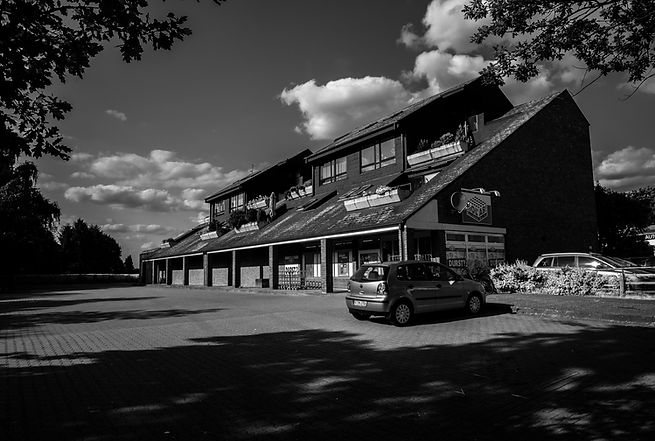
From the film stills I showed him, Pastor Blomberg had no doubt about the farm building, which at the time was actually an agricultural cooperative.
He took me there and pointed out the building’s exact location, today replaced by a more modern construction with a huge sloping roof. I politely expressed my scepticism, because while I accepted that the cooperative had indeed disappeared, I couldn’t figure out the configuration of the place as far as the reverse angle shots and the viewing-angle from the road went.
But when it came to scepticism, the pastor had all the answers... We walked round the building and he introduced me to his friend Karl Reuter, a former military man who now runs a garage and has a memory worthy of an elephant. After studying the stills I showed him, he not only confirmed that it was indeed here that the cooperative had stood, but he immediately recognized the reverse-angle view, with the small Texaco service-station in it. He said it wasn’t in fact located in the same place, but in a hamlet 5 km away.
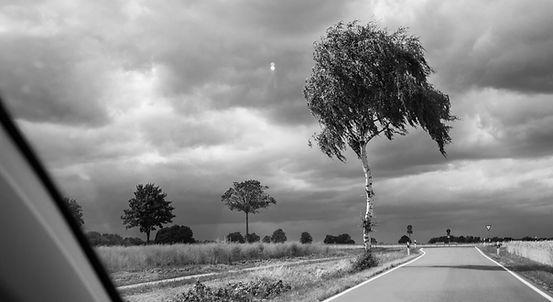

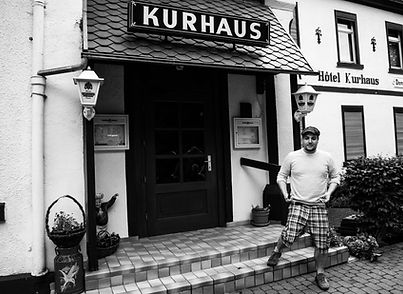
The next film setting was supposed to be in Schöningen. When I got there, I was told it had been turned into a restaurant, the Kurhaus.
The building was huge, the restaurant closed. It didn’t take me long to find the owners, who immediately introduced me to their son, Markus.
He listened to me as I explained the reason for my visit, the memory of Wenders' film ... but he seemed surprised. Silence, then he smiled and said:
"That’s funny, I’m leaving for New York tomorrow morning to find the sets of a film shot in 1978..."

 |  |
|---|---|
 |
I was just as surprised as he was, it was funny indeed... not even that, it was truly amazing! Here’s a guy who arrives in a small town in Lower Saxony with the rather weird idea of finding the sets of a film shot 40 years ago and who bumps into another guy who’s about to cross the Atlantic with the equally weird idea of finding the sets of a film shot 37 years ago...
Markus explained that he was the young founder and editor of a magazine specializing in fantasy films, "Der Zombie", which sold throughout Germany. He was following up the trail of a Walter Hill film released in 1979, entitled "The Warriors". It was a so-called "gang" film about urban guerrilla warfare. Violent and subversive as it was, it was censored when it came out. Markus told me of how his passion for fantasy films had begun at the the Schöningen video club, the sacred place of his childhood...
It’s true we didn’t share a passion for the same films, but over and above this nuance of taste, the similarity of our respective approaches created an immediate rapport between us. Markus interrupted his preparations for the trip and opened up the doors of his parents' restaurant. We were to scratch the walls until we found the memory of the Lichtspiele picture-house.

From Schöningen to Herzberg, losing the thread...
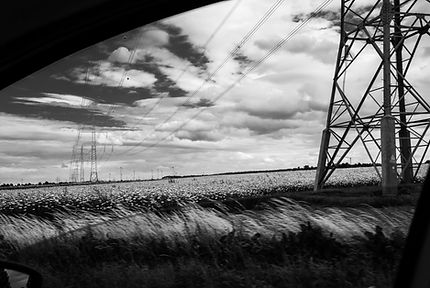


Back on the road, I recognized landscapes from the film, dotted with pylons and cherry-trees blown crooked by the wind. After that, nothing more. The air was cooler, the mountains were getting closer.
Once past Goslar, just plenty of nothing: I drove through the Harz National Park, up and down winding roads through the mountains and pine forests where I seemed to lose the thread.
The days were long, many miles were travelled, and I didn’t recognize a thing. While it was clear that no scene of the film had been shot in this mountainous region, I still had to cross it. Once on the other side, would I find the thread of the film again?... In the meantime, this nothingness left too much room for doubt: did it all make any sense?
 |  |
|---|---|
 |


Kings of the Road
(in the course of time)
The state of things now
A first version of Weisse Wand Road (Kings of the Road - The state of things now) was presented to a fairly limited audience in late 2015. At that time I did not yet consider this website as an end in itself but simply as a way of presenting my work with an eye to developing it further in the form of either an exhibition or a publication. In September 2017, the Wim Wenders Foundation put me in touch with an exhibition curator: David Ellis was organising a cultural event to honour the reopening of a historic picture house in the city of Cluj-Napoca, Romania. Kings of the Road will be screened to mark the cinema’s inauguration and I have been invited to present my work. This invitation has in turn given me fresh impetus to rebuild the site and sign its final version. I now see it as an entity in its own right, to be shared with all those who wish to push on further with their experience of the film (this website has been designed and formatted for viewing on PC screens. An optimized mobile version is available but will not offer you the same reading comfort).
Jérôme Tardieu
WEISSE WAND ROAD
Contact
Web-links
Wim Wenders Foundation
http://wimwendersstiftung.de/en/the-foundation
Film stills
Film Grab, A growing archive of stills from the best film ever
Videos
"Ma bande annonce" , special trailer of the film edited on his own by a net surfer
Articles
Renouer les fils de la mémoire, by Jenny Brasebin (August 2007, Hors Champ)
Au fil du temps (1976) ou la loi du seuil, by Isabelle Singer (2010, Conserveries mémorielles)
Far East (Au fil du temps), by Cornelius (Mars 2010, L'Observatoire)
Acknowledgements
Claire Brunel and Berndt Eichhorn (Wim Wenders Foundation), David Ellis, Monica Sebestyen (Cinema Arta, Cluj-Napoca), Ian Atkins (english version), Dimitri Beck (Polka Magazine), Hacene Boularas (Ordidocteur) / On the road : Ilka and Andreas Klatt, Gisela Stelly-Augustein, Kurt-Ulrich Blomberg, Karl Reuter, Angelika and Harald Pape, Martina and Mathias Torkler, Ben, Mario Shrader, Markus Haage, Gustav Nolte, Heidrun Sporck, Volker Gunzenheimer, Lucia, Petra.
The Logic of Images, Wim Wenders (1991, Faber and Faber)
The Act of Seeing, Wim Wenders (1997, Faber and Faber)
Once, Wim Wenders (2001, Schirmer Mosel)
Renouer les fils de la mémoire (Reconnecting the threads of memory), Jenny Brasebin (August 2007, Hors Champ)
Wim Wenders, Peter Buchka (1986 Rivages/Cinéma)
Interview with Rüdiger Vogler, by Jacques Grant (Munich 1976)
The works and articles cited



English version : Ian Atkins
Jérôme Tardieu / Weisse Wand Road / 2018